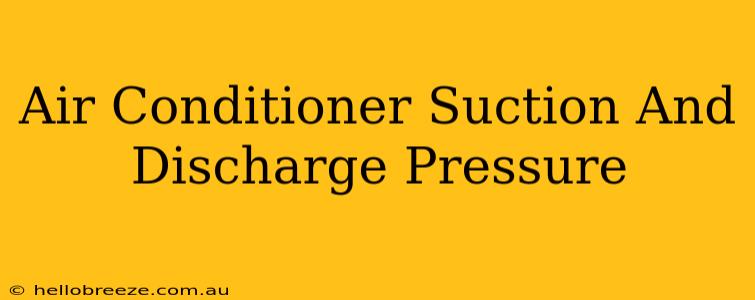Understanding your air conditioner's suction and discharge pressures is crucial for ensuring efficient and reliable cooling. These pressures provide vital insights into the system's health and performance, helping you identify potential problems before they escalate into costly repairs. This guide will break down the significance of these pressures, explain how to measure them, and provide insights into interpreting the readings.
What are Suction and Discharge Pressures?
The refrigerant in your AC system circulates through a continuous loop, undergoing changes in pressure and temperature. Suction pressure refers to the pressure of the refrigerant as it enters the compressor in a low-pressure, low-temperature state. Discharge pressure, on the other hand, measures the pressure of the refrigerant after it leaves the compressor, now at a high-pressure, high-temperature state. The difference between these two pressures is a key indicator of the system's overall efficiency and functionality.
Understanding the Refrigerant Cycle
To fully grasp the importance of these pressures, it's helpful to understand the basic refrigerant cycle:
- Evaporator: The refrigerant absorbs heat from the air inside your home, transitioning from a low-pressure liquid to a low-pressure gas. This is where the suction pressure is measured.
- Compressor: The compressor increases the pressure and temperature of the refrigerant gas, converting it to a high-pressure, high-temperature gas. This is where the discharge pressure is measured.
- Condenser: The high-pressure gas releases heat to the outside air, condensing back into a high-pressure liquid.
- Expansion Valve (or metering device): The high-pressure liquid passes through an expansion valve, which reduces its pressure, preparing it to re-enter the evaporator and start the cycle anew.
How to Measure Suction and Discharge Pressures
Measuring these pressures requires a refrigerant pressure gauge set. These sets typically include two gauges: one for low-pressure (suction) and one for high-pressure (discharge). Never attempt to measure these pressures without the proper tools and training. Improper handling of refrigerants can be dangerous. Always consult a qualified HVAC technician for accurate readings and professional advice.
Identifying the Service Ports
Your AC unit will have service ports – typically low-side and high-side ports – specifically designed for connecting the pressure gauges. These ports are usually capped off to prevent refrigerant leaks.
Connecting the Gauges
Carefully connect the low-pressure gauge to the low-side service port and the high-pressure gauge to the high-side service port. Ensure the connections are secure to prevent leaks.
Interpreting the Readings
The ideal suction and discharge pressures vary depending on several factors, including the type of refrigerant used, the ambient temperature, and the specific AC unit's design. Manufacturer specifications should always be consulted for accurate reference ranges. However, significant deviations from the norm can indicate problems.
Common Issues Indicated by Pressure Readings
- Low Suction Pressure: This could signal leaks in the system, insufficient refrigerant, restricted airflow through the evaporator coil, or a faulty compressor.
- High Suction Pressure: This might indicate a restricted expansion valve, a clogged filter drier, or an overcharged system.
- Low Discharge Pressure: This could suggest insufficient refrigerant, a faulty compressor, or a restricted condenser.
- High Discharge Pressure: This might indicate a restricted condenser, a faulty compressor, or a system that is overcharged.
When to Call a Professional
While understanding suction and discharge pressures provides valuable insights, it's essential to remember that diagnosing and repairing AC problems requires specialized knowledge and expertise. If you notice unusual pressure readings or suspect any issues with your AC unit, contact a qualified HVAC technician immediately. Attempting to fix AC problems without proper training can be dangerous and could further damage the system.
Keywords: Air conditioner, suction pressure, discharge pressure, refrigerant, HVAC, AC repair, troubleshooting, pressure gauge, AC maintenance, cooling system, refrigerant pressure, compressor, condenser, evaporator, expansion valve.

